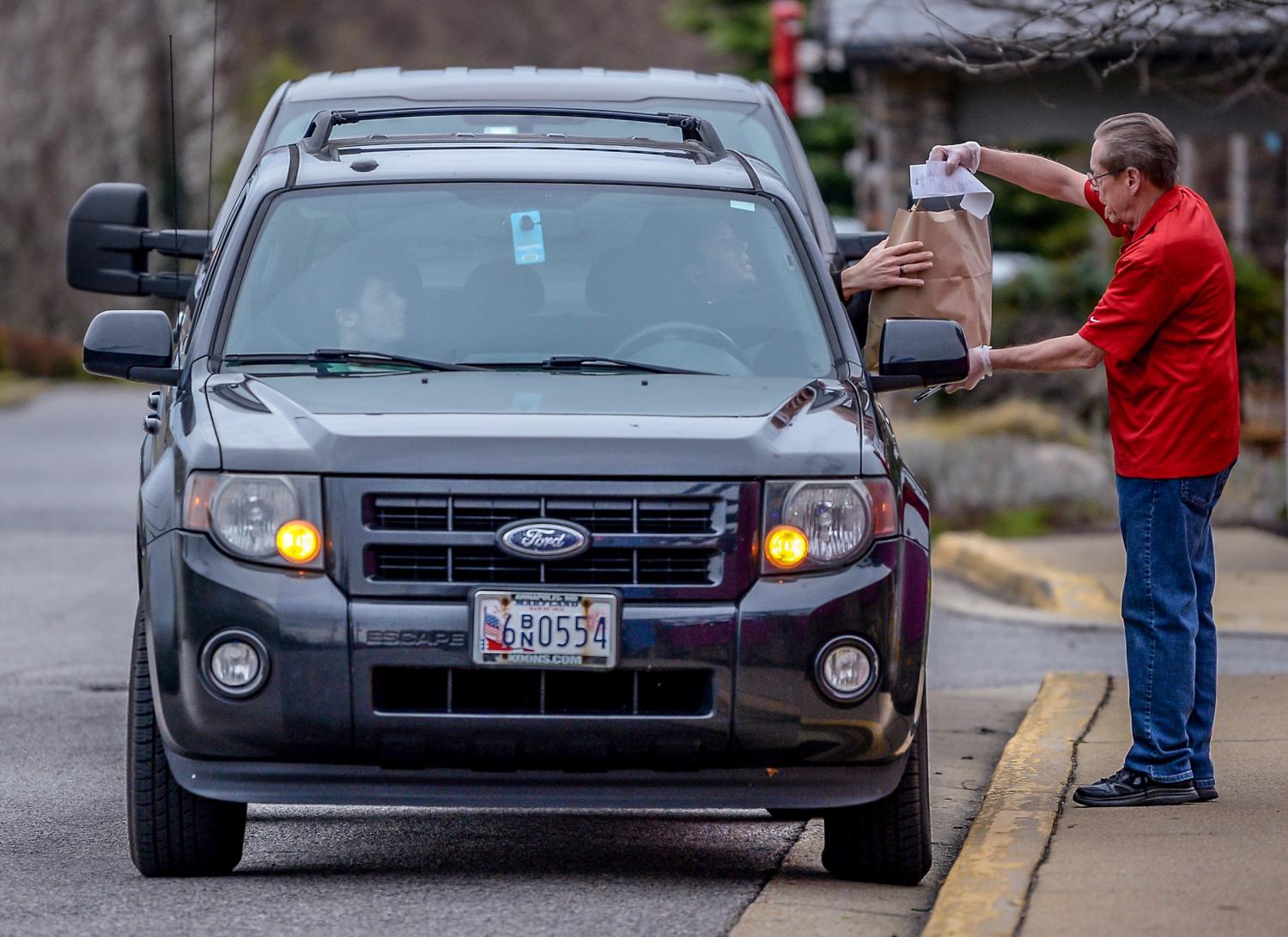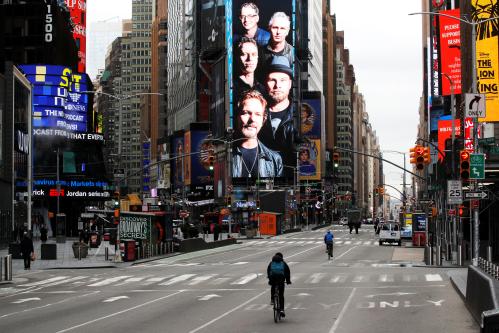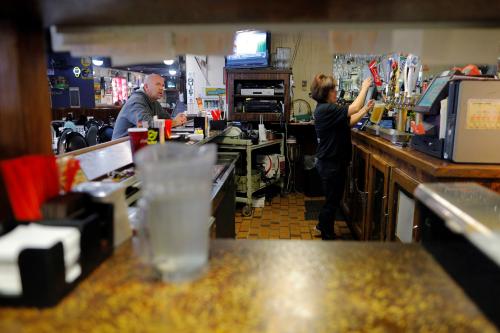Across the country, restaurants and bars are closing their doors to limit the spread of COVID-19. Business owners from New Orleans to Seattle are grappling with overwhelming uncertainty and financial risks, while servers, dishwashers, cooks, and bartenders are finding themselves without a job almost overnight. And for many of them, rent was due yesterday.
Food preparation and service is the second most common occupation in the United States. Waiting tables is the eighth most common. There are more than 12 million Americans working at over 600,000 food service and drinking establishments nationwide.
As of 2016, Americans spent more than half of their food budget eating outside the home. Fueled by this growing trend, bars and restaurants played a significant role in the country’s recovery from the Great Recession. The number of establishments increased 17% between 2009 and 2018, making up over 75% of all growth in the leisure and hospitality sector during this time period. These “third places” are the life blood of many American towns, vital to our cultural fabric and employment base.
This brief captures COVID-19’s rapid impact on the food and beverage industry. In the last week, we spoke with 13 servers (including bartenders and wait staff), managers, and restaurant owners in the Washington, D.C. metro area to understand how the impact is playing out in our own backyard.1 We asked them to share their experiences and perceptions of what has happened over the last three weeks and what forms of support they would find most helpful.
This piece builds on a previous blog post about broader shifts in the retail landscape being accelerated by COVID-19. A forthcoming piece will examine the unemployment insurance (UI) safety net typically available for food and beverage workers and provide an early analysis of what the Coronavirus Aid, Relief, and Economic Security (CARES) Act does and does not do for these workers.
The early impact on food and beverage businesses
The initial effect of the pandemic was a precipitous drop in customers. This has a tremendous impact on both a server’s income and the owner’s revenue. Several business owners and managers that we interviewed noted that delivery and takeout orders were not getting sufficient customer response.
“At first, we decided to do [take-out and delivery], and we had zero foot traffic,” said a manager of a restaurant and entertainment center in Virginia. “We are located in a town center…We have apartment buildings here. We offered apartments delivery and said that we would bring food to them to try to stay open. We did $300 in sales. Labor costs were about $600. Due to this, we unfortunately decided that we had to close our doors.”
The next step for many business owners was to consider how long they could keep their workers on payroll, as well as how to communicate with them about shutting down and their options afterward.
“I made a commitment to our employees to keep the team together, because we have a management team and marketing guy, and sales,” one owner told us. “We have a really tight team of people, but everybody has to take a 20% pay cut. I’m the owner and I’m taking [no pay]. I’m looking to try to leverage or sell off some equity in the business to help raise money to cover those folks so that they don’t end up on unemployment.”
Not all owners are as protective of their staff. One bartender told us that she did not receive official communication from management that she should not report to work until several days after the establishment closed. “I had a shift that was cancelled on [March 14], and they never said anything to me,” the bartender told us. “I don’t feel valued as an employee. I doubt that any of us do.”
Reflecting on what is happening sector-wide, a Baltimore brewery owner shared his concerns that small restaurants will have even more difficulty sustaining payrolls, which he believes will have an almost immediate impact on workers.
“Small business makes up a huge proportion of employment in this country, and when you hit pause for the hospitality industry and a lot of small manufacturers, the payroll is just the first thing to suffer,” said the brewery owner. “Even a really successful restaurant may have a 10% margin, and if you have a big payroll every week and that’s your largest expense, that doesn’t go very far.”
Even after turning off the lights and laying off staff, restaurants and bars will still owe rent. This was top of mind for one owner of a small, family-run mall food stand. “We are really afraid of how we are going to pay the rent,” she told us. “The rent is super expensive, and we are not making any money.”
A manager at a Virginia restaurant added, “One of the things that Italy has done is rent forgiveness…If they were to do rent forgiveness for the month, that would help small businesses everywhere. My restaurant pays $25,000 in rent per month. Even in our slow month, last month, we ended up doing $150,000 in sales. But [what happens] when that drops down to less than $10,000 and we have to pay $25,000 in rent and our loans?”
In addition to rent and debt, some operating costs and other sunk costs such as insurance premiums aren’t as easy to turn off as the utilities. Small businesses need additional liquidity—quickly—in order to meet these obligations or they will fail.
The federal government has moved fairly quickly to provide some relief to small businesses and unemployed workers through the Families First Coronavirus Response Act and the CARES Act. The latter provides $350 billion in loans to businesses with under 500 employees affected by the coronavirus, including up to eight weeks of reimbursement for those loans for payroll, utilities, and other eligible expenses. But it is unclear if this package will be enough.
What’s happening to workers
A typical food and beverage establishment employs “front-of-house” employees (such as servers, bartenders, hosts, and bussers), back-of house employees (cooks, dishwashers, and food prep workers), and managerial or supervisory staff. Work arrangements in this sector range tremendously, from entry-level, mostly part-time staff with no health insurance or other benefits (more common in smaller or lower-cost establishments) to highly experienced, full-time staff with benefits (more common in high-end and larger companies).
Across our interviews, workers, managers, and owners alike expressed feeling overwhelmed and fearful about what would happen to the industry in the coming months. Servers and managers we interviewed were in different financial positions depending on whether they had savings, debt, existing health conditions, or a partner who was employed or had health insurance. Several noted that most of workers in the industry tend to live paycheck-to-paycheck.
The top concerns of workers were how they would pay their rent or mortgage, whether they would lose their health insurance (if they had it), what they would do if they got sick (especially if they did not have health insurance), how they would pay for food and utilities, and whether they would get further in debt than they already were.
“I have cancer, so I can’t really go out at all,” one manager told us. “My next scan is scheduled for May 11, and I don’t know if I’m going to get it.”
Some of the workers and managers we interviewed had health insurance through a partner, but most said that they were uninsured or would lose their health insurance by the end of April. The CARES Act does not include provisions for those who are or will become uninsured due to job loss or benefit cuts. Those working in the restaurant industry who contract COVID-19 or experience another adverse health event in the coming months may face increased medical debt, on top of everything else.
Workers and managers we interviewed were especially concerned about their establishments’ dishwashers. Dishwasher positions are typically very low-paid hourly workers, often occupied by recent immigrants—both the undocumented and those who have legal authorization to work.
“I really feel for people who don’t have documentation who are already here and working their asses off, because they are getting really screwed right now,” one server told us. “I want some sort of compassionate response. We can say, ‘Okay, you need to eat, and you can’t pack up and go back to El Salvador right now, so what can we do?’”
Although the CARES Act expands unemployment insurance (UI) eligibility to low-wage workers who would not normally meet their state’s minimum income requirements, it does not expand it to undocumented workers.
Almost everyone that we interviewed felt that a $1,200 direct payment from the federal government was a good start, but won’t be enough if the pandemic continues for several months. “My rent is $1,700,” one server said. “No, $1,200 is not enough. It might be enough for somebody in the middle of the country, but not for people in big cities.”
Several people we interviewed suggested suspending rent payments until the pandemic ends, and compensating landlords or banks for it.
“D.C. is not allowing any evictions, but I’m banned from working, legally banned from collecting an income,” one server told us, referencing the ban on in-restaurant dining. “I don’t think it’s fair that my landlord gets paid. It’s a little unfair when the government says, ‘You can’t have a job anymore.’ But they can still take your money.”
The CARES Act retroactively adds $600 to unemployment insurance benefit levels from January 27 until July 31, 2020. But it is unclear to what extent state labor agencies will be able to implement these changes smoothly and accurately on such short notice given the unprecedented demand on their UI systems. For now, many state labor agencies are recommending that applicants wait until their agency announces that their system has incorporated CARES Act changes before they reapply. UI experts estimate that it will take a minimum of two to three weeks to do so.
How to help the industry right now
In our interviews with workers, managers, and owners in the food and beverage industry, we asked for their ideas on what forms of support would be most helpful. We organized their responses into three basic categories that should be the focus of policymakers moving forward.
- Facilitate fast and adequate implementation of the relief packages. Even in the absence of a crisis, the country’s UI system tends to be very complicated and difficult for unemployed workers to navigate. The typical eligibility rules exclude many workers, and each state has different system, which are now largely automated and often antiquated, so it can be hard to obtain staff assistance. The changes to UI under the CARES Act will be extremely challenging for federal agencies and state governments to implement in the midst of this crisis, so they will need more support. At the legislative level, designing a nationally consistent solution that minimizes confusion and streamlines implementation will help.
- Act quickly to save small businesses. Owners expressed concern about whether the new small business loan program could be implemented before a rash of establishments permanently close. States and local jurisdictions should consider bridge programming such as Indiana’s Rapid Response fund to get immediate support to businesses and encourage them to treat layoffs as a last resort through alternatives such as work sharing, also known as short-time compensation.
- Address the lack of health coverage during the pandemic (and beyond). The federal relief packages passed so far do not include health insurance options (other than those already available, such as Medicaid). Millions of Americans in the food and beverage industry never had health insurance or will lose employer-provided coverage before the end of April.
- Address the lack of paid sick leave. We have yet to address the lack of paid sick leave for many individuals who cannot work due to quarantines, family care responsibilities, or contracting COVID-19. This also holds true for undocumented workers.
- Minimize the impact of coronavirus on personal debt levels. Given the disproportionate debt burden borne by low-income Americans (such as auto loans and medical debt), we can anticipate that individuals experiencing income loss from COVID-19 will have trouble paying what they owe. This crisis may compound their debt and expose them to other negative consequences from nonpayment if they cannot access available relief programs.
- Consider rent and mortgage freezes. Housing-related debt (either lease debt or mortgage debt) is a typical American’s largest expense. Temporary bans on evictions and foreclosures may keep people in their homes for now, but they do not reduce overall rent or mortgage obligations for many reasons. Most businesses also owe rent. Many people we spoke to in the industry believed that suspending both commercial and residential rent would be the most helpful immediate solution.
- Adjust future stimulus checks for costs of living. The CARES Act authorizes a $1,200 check to every adult who earns less than $75,000 per year (scaling down to zero for higher-earning workers—calculate your check amount here). The workers, managers, and owners that we spoke to said that $1,200 checks are a good start. However, because payments are not adjusted for areas with a high cost of living and because we are unsure how long the crisis will continue, workers fear that $1,200 will not be enough. One owner described them as “a Band-Aid on a gunshot wound.”
Saving the industry is a collective action
Economic hardship and insecurity have already begun to manifest in the lives of food and beverage industry workers and business owners. State and local administrators have been working overtime to do the best they can, but the reality is that a crisis of this scale will require an all-hands-on-deck solution, in which everybody who has the means to help should do so.
Philanthropy, corporations, and wealthy donors can play a key role in providing funding to boost immediate response efforts and awareness of available support to those who are most heavily impacted. For instance, some internet service providers are offering free or low-cost internet service during the pandemic. Some restaurants and wealthy individuals have set up crowdfunding and social media campaigns to donate cash to unemployed restaurant workers.
Many community-based organizations, food banks, job centers, training providers, and other organizations are ramping up their virtual and telephone access to food delivery, health care, employment, and training needs. However, they too will probably need time and additional resources to get systems fully online and new operating modes in place to meet crisis levels of demand.
Some resources are emerging to help jobless workers navigate relief systems, including UI. For example, overloaded state systems have led to a surge in outside portals for support and information, such as this one on Reddit or this one-on-one assistance option for gig workers.
Employers that need to resort to layoffs can consult resources about how to communicate bad news to their workforce in a way that is respectful and informative. Many of the workers that we interviewed reported a lack of communication or explanation about why management felt that they needed to resort to layoffs.
Above all, the U.S. needs to take stock of its safety net during this crisis and make sure it aligns with the value that our small businesses and service industry workers bring to the economy. “I don’t see a huge push by anyone to be a voice for people in the service industry,” one owner told us. “These are the hardest hit—the people that everybody takes for granted.”
The future of the food and beverage industry is uncertain, but it is very clear that the people who work in it are suffering immensely right now, and require unprecedented reassurance and relief.
“It has killed me to do all this,” one owner said after he described laying off almost his entire staff. “It made me cry. It’s making me cry again. You think you have everything in hand, and, then…It’s too hard to put it to reason. It’s just so weird. Who knows? So, I worry about everyone.”
The authors wish to extend special thanks to the owners, managers, servers, and bartenders in the food and beverage industry who took the time to share their experiences and perspectives with us.
-
Footnotes
- The sample included four small business owners, five managers or supervisors, and four wait staff or bartenders. We did not reach any dishwashers, cooks, or other back-of-the-house workers for inclusion in the sample, so we cannot speak to whether or not their experiences varied from those reported here or whether there were differences across subgroups of workers, such as by race or ethnicity. Although the sample size is small, small sample sizes are common in qualitative research and the scope of this brief was to conduct a preliminary investigation into the initial effects of the pandemic on those who work in the food and beverage industry in the Washington, D.C. region. Additional research is needed to better understand how the pandemic will affect this industry and its workers more broadly.








